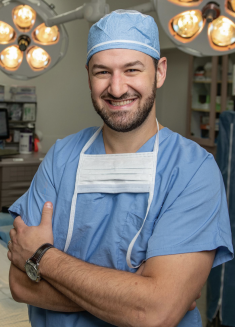After a bullet, a missed stent and years of complications, one precision surgery at Rutgers New Jersey Medical School helped a patient reclaim his quality of life
Thirteen years of complications ended with a three-centimeter robotic incision for "Bob," now 51 years old, thanks to urologists with the Rutgers New Jersey Medical School.

In 2011, a gunshot to his abdomen required major surgery at another institution. The bullet sliced his ureter, which transports urine from the kidney to the bladder. To help it heal properly, doctors inserted a stent, a plastic device typically deployed for three to six months.
Forgotten, the stent became encrusted, which required more invasive procedures, culminating in 10-centimeter long-scar that caused severe narrowing of three-quarters of Bob's ureter. Without repair, Bob would require a lifelong tube in his back to drain his kidney, which is very uncomfortable and could lead to infections. With such a challenging scar, doctors contemplated removing the affected kidney or leaving a tube inside him permanently, which could lead to infections and discomfort. Neither seemed an ideal choice for Bob.
Enter associate professors Amjad Alwaal, director of urologic reconstruction and men's health, and Evan Kovac, director of urologic oncology and robotic surgery at Rutgers New Jersey Medical School (NJMS) and University Hospital. Together, they hoped to save the kidney, which still had good function.
"But the last thing we wanted to do was go into his abdomen again," Kovac said. "It was a hostile environment with a lot of scar tissue," adding there was a risk of injuring other structures and organs.
The team turned to a surgical robot. This minimally invasive procedure - introduced in 2018 - relies on one small keyhole incision into the patient's navel or abdomen, versus the usual three to five incisions. All instruments enter the body through this channel, then fan open. One bonus is this technique can lead to less pain and quicker recoveries.
It was a great victory. His quality of life has drastically improved now.
Evan Kovac
Director of Urologic Oncology and Robotic Surgery, Rutgers New Jersey Medical School and University Hospital
"We did this retroperitoneally, making an incision in the patient's side to stay away from the complex and scarred abdominal cavity," Kovac said.
The surgical team then reconstructed the ureter with smooth, wet mucosal tissue from inside Bob's cheek. Alwaal harvested this buccal sample, then halved it lengthwise, tying the pieces end-to-end. Then Kovac planted it on the psoas, a significant hip flexor muscle, which has the strong blood supply a graft needs to survive.
"To our knowledge, this was one of the longest single-port, retroperitoneal, buccal graft ureteroplasties on record," Kovac said. "I didn't invent the procedure. I'm standing on the shoulders of giants who developed this technology and approach. But it certainly is cool."
Within a few months of the April 2024 surgery, Bob had 5% better kidney function on his impaired side than he had two years previously.
"It was a great victory," Kovac said. "He was dealing with infections before, and also a nephrostomy tube, which pierced his back and drained urine into a bag wrapped around his thigh. These can become displaced and infected. They're not comfortable and make it hard to sleep. His quality of life has drastically improved now."

Kovac added, "This was a team effort. It was my first robotic ureteroplasty, let alone a single-port, retroperitoneal, buccal-graft ureteroplasty. But Alwaal really supported me. He was my guide and collaborator throughout the whole case. It's a nice example of how our division has experts across different areas of urology and how satisfying it is to come together to collaborate."
Kovac said his department relishes creative applications of the university's state-of-the-art tools - a vital trait at a hospital that fields complex cases other health care systems might pass on.
"At NJMS, we put our heads together to help patients," Kovac said. "We leverage training, technology, and knowledge of anatomy to innovate and solve problems."
He has been involved in another of those recently, developing a prostate cancer testing brochure published in four languages.
"The diagnostic prostate-specific antigen test is somewhat controversial," Kovac said. "It does find cancer, but a lot of the cancers found are not deadly and may be treated anyway, leading to stress and negative side effects on both urinary and sexual function. In fact, prostate cancer is very slow growing. The longer you live, the more likely you will get it. The question is whether it will negatively impact you in your lifetime if detected by screening."
The booklet helps patients make informed decisions. It also introduces "some ideas that are a bit avant-garde," said Kovac, like not necessarily needing to test every person every year. "I put this together in 2021 in collaboration with our primary care leaders. Now we have data showing it is very useful for our patients."






